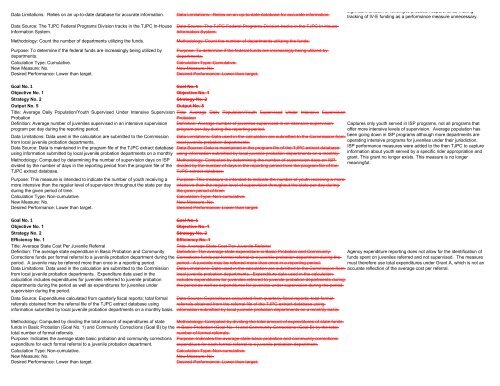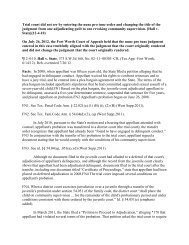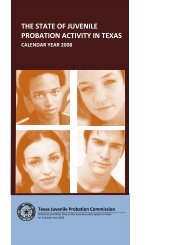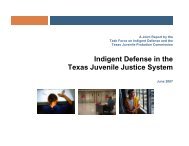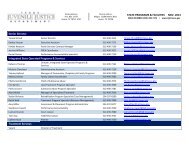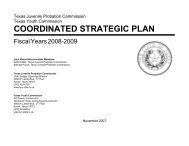(TJJD) Office of Inspector General - Texas Juvenile Justice Department
(TJJD) Office of Inspector General - Texas Juvenile Justice Department
(TJJD) Office of Inspector General - Texas Juvenile Justice Department
You also want an ePaper? Increase the reach of your titles
YUMPU automatically turns print PDFs into web optimized ePapers that Google loves.
Data Limitations: Relies on an up-to-date database for accurate information.Data Source: The TJPC Federal Programs Division tracks in the TJPC In-HouseInformation System.Methodology: Count the number <strong>of</strong> departments utilizing the funds.Purpose: To determine if the federal funds are increasingly being utilized bydepartments.Calculation Type: Cumulative.New Measure: No.Desired Performance: Lower than target.Data Limitations: Relies on an up-to-date database for accurate information.Data Source: The TJPC Federal Programs Division tracks in the TJPC In-HouseInformation System.Methodology: Count the number <strong>of</strong> departments utilizing the funds.Purpose: To determine if the federal funds are increasingly being utilized bydepartments.Calculation Type: Cumulative.New Measure: No.Desired Performance: Lower than target.IV-E funding to juvenile probation departments has declineddramatically since 2007. IV-E funding no longer accounts for asignificant amount <strong>of</strong> funding to probation departments, makingtracking <strong>of</strong> IV-E funding as a performance measure unnecessary.Goal No. 1 Goal No. 1Objective No. 1 Objective No. 1Strategy No. 2 Strategy No. 2Output No. 5 Output No. 5Title: Average Daily Population/Youth Supervised Under Intensive Supervision Title: Average Daily Population/Youth Supervised Under Intensive SupervisionProbationProbationDefinition: Average number <strong>of</strong> juveniles supervised in an intensive supervisionprogram per day during the reporting period.Data Limitations: Data used in the calculation are submitted to the Commissionfrom local juvenile probation departments.Data Source: Data is maintained in the program file <strong>of</strong> the TJPC extract databaseusing information submitted by local juvenile probation departments on a monthlybasis.Methodology: Computed by determining the number <strong>of</strong> supervision days on ISPdivided by the number <strong>of</strong> days in the reporting period from the program file <strong>of</strong> theTJPC extract database.Purpose: This measure is intended to indicate the number <strong>of</strong> youth receiving amore intensive than the regular level <strong>of</strong> supervision throughout the state per dayduring the given period <strong>of</strong> time.Calculation Type: Non-cumulative.New Measure: No.Desired Performance: Lower than target.Definition: Average number <strong>of</strong> juveniles supervised in an intensive supervisionprogram per day during the reporting period.Data Limitations: Data used in the calculation are submitted to the Commission fromlocal juvenile probation departments.Data Source: Data is maintained in the program file <strong>of</strong> the TJPC extract databaseusing information submitted by local juvenile probation departments on a monthlybasis.Methodology: Computed by determining the number <strong>of</strong> supervision days on ISPdivided by the number <strong>of</strong> days in the reporting period from the program file <strong>of</strong> theTJPC extract database.Purpose: This measure is intended to indicate the number <strong>of</strong> youth receiving a moreintensive than the regular level <strong>of</strong> supervision throughout the state per day duringthe given period <strong>of</strong> time.Calculation Type: Non-cumulative.New Measure: No.Desired Performance: Lower than target.Goal No. 1 Goal No. 1Objective No. 1 Objective No. 1Strategy No. 2 Strategy No. 2Efficiency No. 1 Efficiency No. 1Title: Average State Cost Per <strong>Juvenile</strong> ReferralTitle: Average State Cost Per <strong>Juvenile</strong> ReferralDefinition: The average state expenditure in Basic Probation and Community Definition: The average state expenditure in Basic Probation and CommunityCorrections funds per formal referral to a juvenile probation department during the Corrections funds per formal referral to a juvenile probation department during theperiod. A juvenile may be referred more than once in a reporting period. period. A juvenile may be referred more than once in a reporting period.Data Limitations: Data used in the calculation are submitted to the Commissionfrom local juvenile probation departments. Expenditure data used in thecalculation includes expenditures for juveniles referred to juvenile probationdepartments during the period as well as expenditures for juveniles undersupervision during the period.Data Source: Expenditures calculated from quarterly fiscal reports; total formalreferrals obtained from the referral file <strong>of</strong> the TJPC extract database usinginformation submitted by local juvenile probation departments on a monthly basis.Data Limitations: Data used in the calculation are submitted to the Commission fromlocal juvenile probation departments. Expenditure data used in the calculationincludes expenditures for juveniles referred to juvenile probation departments duringthe period as well as expenditures for juveniles under supervision during the period.Data Source: Expenditures calculated from quarterly fiscal reports; total formalreferrals obtained from the referral file <strong>of</strong> the TJPC extract database usinginformation submitted by local juvenile probation departments on a monthly basis.Methodology: Computed by dividing the total amount <strong>of</strong> expenditures <strong>of</strong> state Methodology: Computed by dividing the total amount <strong>of</strong> expenditures <strong>of</strong> state fundsfunds in Basic Probation (Goal No. 1) and Community Corrections (Goal B) by the in Basic Probation (Goal No. 1) and Community Corrections (Goal B) by the totaltotal number <strong>of</strong> formal referrals.number <strong>of</strong> formal referrals.Purpose: Indicates the average state basic probation and community correctionsexpenditure for each formal referral to a juvenile probation department.Calculation Type: Non-cumulative.New Measure: No.Desired Performance: Lower than target.Purpose: Indicates the average state basic probation and community correctionsexpenditure for each formal referral to a juvenile probation department.Calculation Type: Non-cumulative.New Measure: No.Desired Performance: Lower than target.Captures only youth served in ISP programs, not all programs that<strong>of</strong>fer more intensive levels <strong>of</strong> supervision. Average population hasbeen going down in ISP programs although more departments areoperating intensive programs for juveniles under their jurisdiction.ISP performance measures were added to the then TJPC to captureinformation about youth served by a specific rider appropriation andgrant. This grant no longer exists. This measure is no longermeaningful.Agency expenditure reporting does not allow for the identification <strong>of</strong>funds spent on juveniles referred and not supervised. The measuremust therefore use total expenditures under Grant A, which is not anaccurate reflection <strong>of</strong> the average cost per referral.


